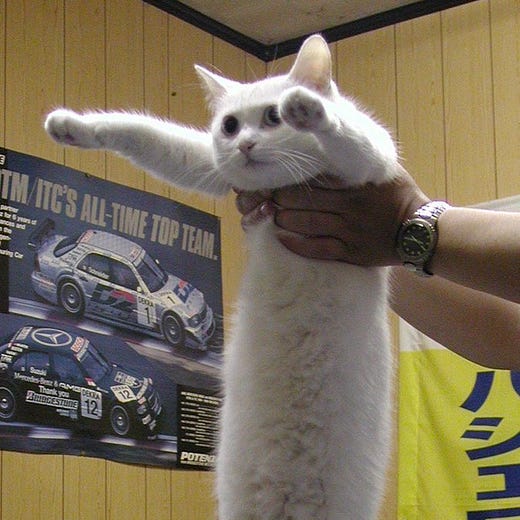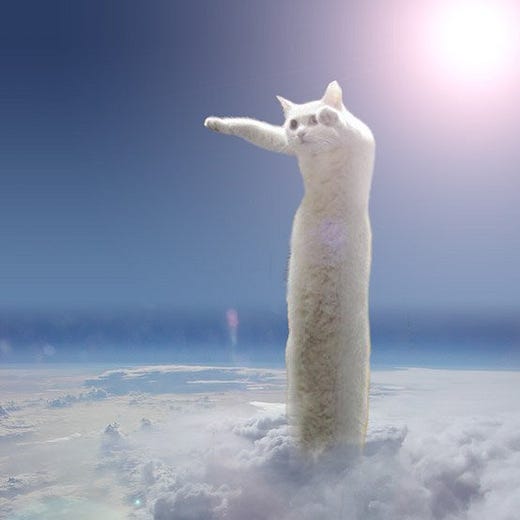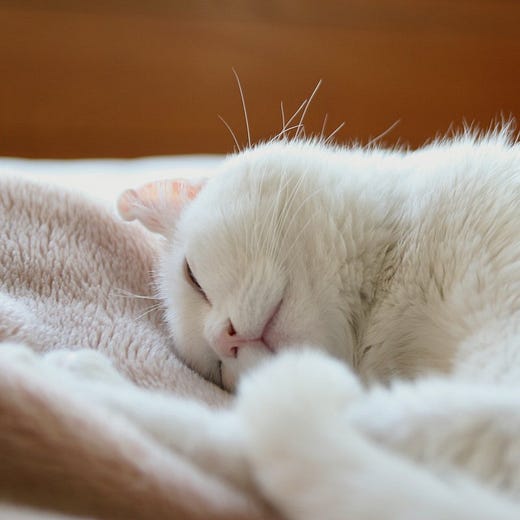Tacgnol's world
what will we do without Longcat?
Over the weekend, news broke that one of history’s most influential and celebrated titans passed away: Longcat has crossed the Rainbow Bridge. Known formally as Nobiko, she was 18.
Google roughly translates this as:
Nobiko, I just crossed the Rainbow Bridge.
I suddenly became respiratory failure and worked hard for about 4 hours.
Nobiko did her best to the end.
This is Elaiko.
Nobiko’s owner has been tweeting a lot since she passed away. Nobiko playing with a flashlight in 2006, Nobiko this past August (“At this time, I never thought that it would be gone.”), Nobiko’s final moments (“Nobiko was in the car with a calm face even when she was taken to the hospital”). What a sweet cat.
Longcat became famous on the internet around 2006, when the internet was much smaller and slower than it is now. She first appeared on 2chan, and then made her way to 4chan. She became famous because, when held by her armpits, she was very long. It was funny to photoshop the long cat.
(A tweet revealing that Longcat was still alive, May 2019)
In reflecting on Longcat, I was trying to imagine how I would explain her fame to someone who was unfamiliar with her. By the standards of contemporary internet fame, her popularity is mostly inarticulable. Longcat doesn’t do anything funny, nor is she particularly visually distinct. Her notoriety all comes down to one curious picture. No incessant social media presence, no branding, no anthropomorphization — just “hey, look at this thing.” That was really all you needed to arbitrarily become internet-famous in 2006: one intriguing JPEG. Just to give you an idea of the depth of thought surrounding this meme, the most insightful sentence associated with this animal is “Longcat is long.”
Longtime readers of BNet will recall that I do not entirely grasp the appeal of influencers, and yet, in a certain sense, Longcat’s popularity was a precursor to this type of internet object. Longcat initially became famous because of a single piece of media, but then Longcat became even more famous because, well a lot of people were talking about her. Longcat was something you kept joking about and making image macros about because Longcat was also what everyone else was joking about and making image macros about.
All of the Longcat mythos was completely invented by bored people with a surplus of time to surf the web. My favorite subnarrative of Longcat’s story was her battle against Tacgnol, a cataclysmic event foretold in ancient texts. According to Encyclopedia Dramatica:
Tacgnol, not to be confused with Shortcat, is the long awaited challenger to Longcat. It is prophesised that there will be an epic battle for the universe and all eternity, the Catnarok, that will take place on Caturday. The outcome of this will bring the age of Tacgnol.
It was very silly and stupid. It was great.

If Longcat’s arbitrary popularity was a precursor to the arbitrary popularity of influencers, then it’s worth examining the differences as well. Though we now know Longcat’s real name and heritage, she was also part of an elite group of early internet cats who became famous for a single image. Happy Cat, Ceiling Cat, and Limecat also come to mind. These days there are countless funny, viral images of pets — but these were the first.
These cats are substantially different from famous cats like Lil Bub and Grumpy Cat. Grumpy Cat in particular seems diametrically opposed to Longcat, having been heavily anthropomorphized in image macros, and totally selling out, slapping her grumpy visage on everything from t-shirts to coffee beans to Lifetime movies.
Being a famous pet online now requires the pet to have a persistent presence — a brand — and thus they are famous simply for existing, and not for one piece of media in the way that Longcat is. Even among contemporary famous pets, there is an aesthetic judgement being made that was absent with Longcat. Lil Bub was a permakitten with deformities that, I’ll admit, made her look cartoon-cute. Marnie the Dog has a similar situation. Grumpy Cat, by looking annoyed, occupied a sort of “relatable” space that we demand our online celebrities inhabit. Longcat, by contrast, was not particularly cute, nor was she particularly relatable. How exactly does a human relate to being long?
Simply put, Longcat was a form of collective storytelling set off by a mildly amusing photo of a standard household cat. As far as I can recall, nobody demanded more information about Longcat. Nobody asked Longcat’s owner to set up a blog or a social media account for persistent updates on what the real Longcat was up to. Nobody cared! That’s what made the idea of Longcat so powerful for so long: there was no reality to encroach upon the myth. Everyone — even Longcat’s caretakers — implicitly understood that who Longcat was in real life was not actually relevant to the memecraft.
But that understanding didn’t stop an outpouring of grief over the last couple of days as people around the world paid tribute to Nobiko’s legacy. We might not have known the real Longcat, but we knew what she gave us.
Regardless, Longcat is gone now. It’s Tacgnol’s world, we just live in it.
Something to consider

Elsewhere…
today marks the 27th anniversary of pingas
this is the first recipe blog post I’ve read that contains the sentence “The Fukushima accident was very unfortunate and it hits me hard because I have a degree in nuclear engineering and have been working in the nuclear power industry for over 20 years.”
you love to see people learning new words, like upset
it’s kinda getting run into the ground but the clip of the twins saying “da vinci” mostly lives up to the hype



